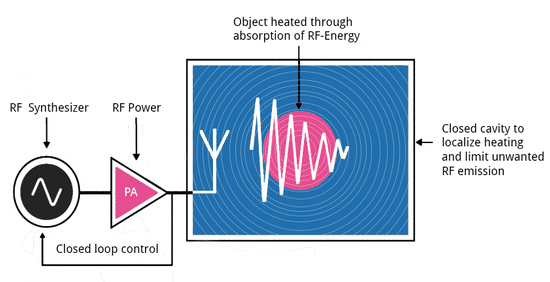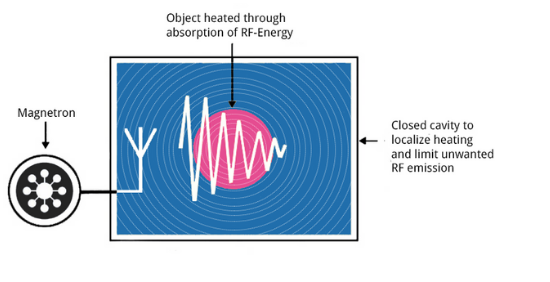RF energy denotes a novel energy source making use of high frequency electromagnetic energy to power all kinds of applications in a VERY controlled way. This is in contrast to “ordinary” energy sources like infrared radiation or convection heaters or microwave ovens where the control of energy is LIMITED when compared to a RF Energy source. A very familiar example of a currently available heating source is the domestic microwave oven that is often used to reheat food. In today’s appliances the RF energy is typically provided by a legacy microwave tube: the magnetron. The main limitation of the magnetron is it’s limited ability to adjust it’s output power especially in a changing environment. It’s really a brute force way of heating. Another limitation of magnetrons is that the output power degrades over time and especially in industrial applications this can require expensive maintenance and replacement

What is solid state RF Energy ?
Solid state generated RF power on the other hand has much better control, it’s very robust and barely degrades over time and it has become economical to implement. This added controllability is really the core advantage of the new technology. It enables a number of improvements for existing RF powered applications, and at the same time is also enabling a host of new ones like plasma lighting, medical treatments or automotive ignition. Solid-state RF systems have started to replace magnetrons within the following applications: Industrial heating and drying, Chemical processing, Plasma generation, Commercial cooking (restaurants, fast reheat and thawing), Medical treatments, Consumer microwave ovens. On top of this, new exciting applications are expected to emerge.



SMART Solid-State Heating
Solid-state RF energy uses transistor technology to generate powerful RF fields. This is the same technology that has been used to power the signals on our mobile telephone networks. Solid-state RF-driven applications benefit from very agile control of the created electromagnetic fields (frequency, phase, power level, on/off can be changed on a microsecond timescale). The controller can react to any change or requirement instantly and can always guarantee optimal use of the irradiated RF energy for an optimal process result.
Advantages
- Solid-state RF heating offers breakthrough control functionalities
- They are smaller than tube based systems like magnetrons
- They are accurate and have fast control and can adapt to changing dielectric constants
- They have better integral energy efficiency as the energy is matched into the material being heated
- They are enabling new applications, e.g. plasma spark plugs, ablation for cancer treatment, plasma lighting etc
Classical RF Heating
As an example, the typical home microwave oven as we know it today heats food based on magnetrons, which are tube-based. This is really a brute force way of heating as the magnetron is always delivering its maximum power of around 1000W, even if less power is required.
Disadvantages
- Magnetrons are bulky and offer limited control
- Limited reliability, high cost of ownership
- Slow control
- No power feedback
- No frequency control


